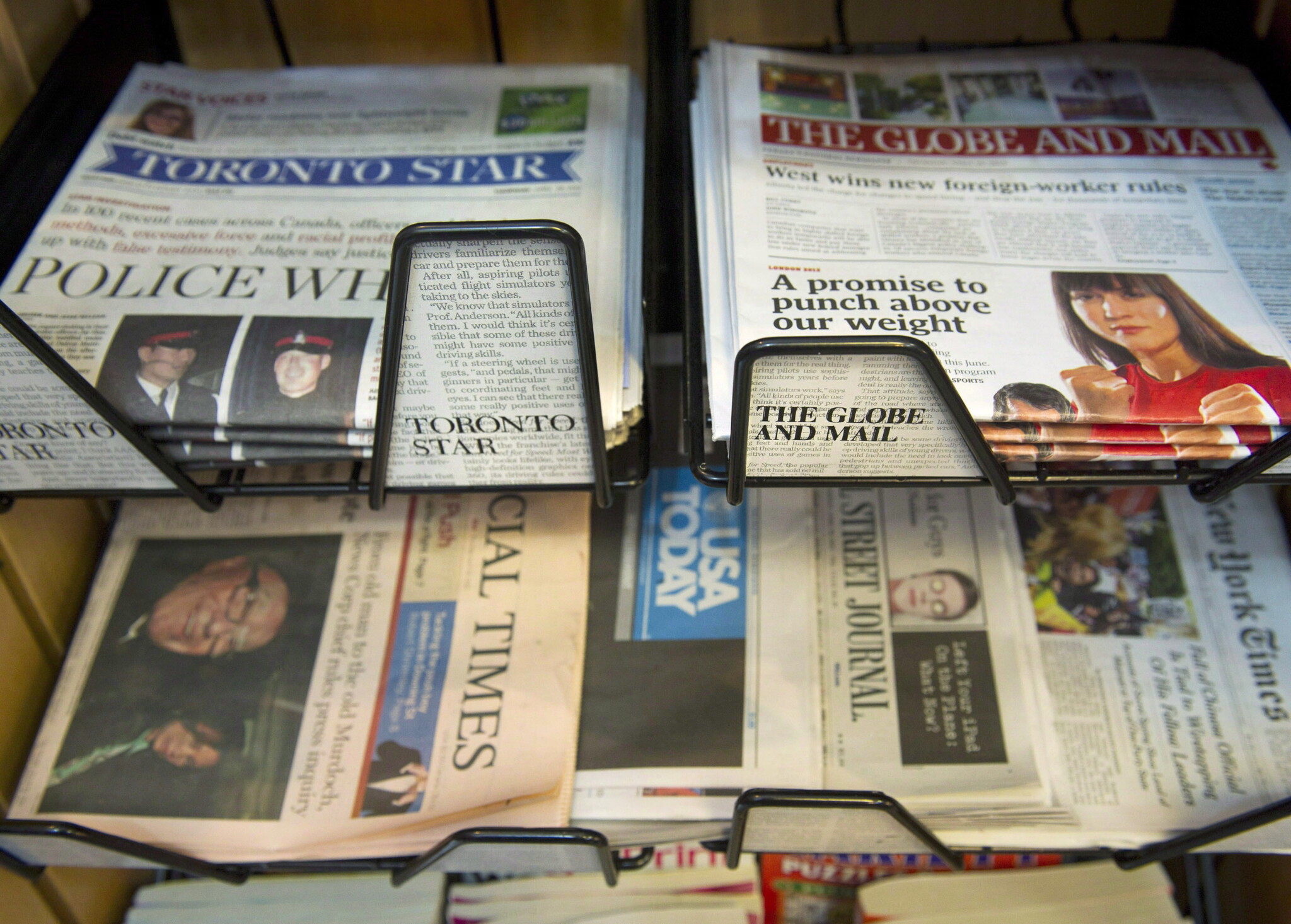The irony could not have been more delicious as Globe and Mail columnist Andrew Coyne threw around the T-word—Treason!—recently in connection with the National Security and Intelligence Committee of Parliamentarians (NSCICOP) report on foreign political interference. “What else do you call it when people conspire against their own country?” asked the headline on his column.
Our reluctance to call the allegations against unnamed MPs what they really are might come from public indifference and a decline in expectations brought by decades of scandal, mused Coyne, or simply from not taking them seriously enough. “Treason, we feel, is not the sort of thing that happens in Canada. It’s too big, too bad, too real.”
The irony is that Canadian mainstream news media are also included in the report’s allegations.
While the specifics have been omitted, I believe the Globe and Mail has been among those most complicit.
It’s not something you will read much about in our mainstream press, especially in Canada’s newspaper of record.
From what I can tell, this angle has so far only been reported by right-wing websites True North and Rebel News, along with a Red Deer Alberta local news site called Todayville. Coyne did, however, at least mention the allegations in a subsequent column.
“It is not illegal to pay Canadian media to produce coverage that portrays a foreign state in a positive light or to amplify the official policy of a foreign state,” noted the NSCICOP report.
“When that state conceals its involvement, however, this activity is no longer within the bounds of acceptable diplomacy and lobbying: it is foreign interference.”
When it comes to covertly influencing Canadian opinion through media, the People’s Republic of China (PRC) has been the “most capable,” the report continued. Sources in the intelligence community noted that it has been “interfering with Canadian media content via direct engagement with Canadian media executives and journalists.”
The next six sentences were deleted “to remove injurious or privileged information,” the report explained, revealing only that they “described examples of the PRC paying to publish media articles without attribution, sponsoring media travel to the PRC, pressuring journalists to withdraw articles and creating false accounts on social media to spread disinformation.”
A 2020 report by NSICOP was slightly more forthcoming about China’s foreign influence media strategy called “borrowing a boat to go out into the ocean” to co-opt mainstream media into publishing its propaganda. “This often takes the form of strategic partnerships with media to provide free PRC-approved messages for China-related news, similar to a wire service. Sometimes, the content is supplemental and paid for through advertisement.” One example it noted was the multi-page supplements appearing in large newspapers around the world, including the New York Times, the Wall Street Journal, the Washington Post, and the Daily Telegraph.
“These inserts, called ‘China Watch,’ look like part of the newspaper, but are propaganda for which the Telegraph alone reportedly receives EUR750,000 (approximately C$1.3 million) annually,” they conclude. What they fail to mention is that these Chinese propaganda brochures (put out by the Publicity Department of the Chinese Communist Party) have also been featured prominently here in Canada.
Right: The Globe reports on allegations of forced Uyghur labour in Xinjiang. Left: The Globe and Mail again publishes propaganda from the Publicity Department of the Chinese Communist Party. Same newspaper. Same day. Does not compute @globeandmail pic.twitter.com/iDAqgeZMxb
— Harrison Lowman (@harrisonlowman) December 12, 2020
While often taking a hawkish editorial stance and reporting approach on the rising world superpower, the Globe and Mail has been featuring paid CCP propaganda in its pages since at least 2016, when an eight-page section of China Watch headlined “A new Trudeau, a new era.” was published. A small line of type at the top of every page noted that the supplement had been “produced by China Daily and distributed in the Globe and Mail.”
China Daily is a state-owned newspaper that boasts the highest circulation of any English-language newspaper in China. Its U.S. operations are controlled by the CCP’s “Central Leading Group on Foreign Propaganda.” A 2021 disclosure filed in the U.S. under its Foreign Agents Registration Act by the China Daily Distribution Corporation (the company behind China Daily and China Watch) showed that it paid the Globe and Mail US$329,898.59 (C$453,636.83) over a six-month period in 2020-21 for “advertisement expenses.”

The Globe and Mail appears in a 2021 Foreign Agents Registration Act disclosure by the China Daily Distribution Corporation. Source: U.S. Department of Justice
A two-page spread in the Globe and Mail’s business section in September 2020 contained only “cheerful stories,” noted Toronto Star columnist Rosie DiManno, adding that they featured this while two arbitrarily detained Canadians (the two Michaels) sat in Chinese prisons.
“The Globe has accepted Judas silver coins to whoremonger for the Communist Party that rules The People’s Republic of China,” the Toronto Star columnist wrote. “China is a bully and the Globe, alas, is a pimp.” But her remarks land less of a punch when one realizes that Torstar’s Metroland Media also bagged C$73,397.79 for China Daily printing expenses.
Such “pay-for-play journalism,” added iPolitics, threatened our free press.
While the Globe and Mail did not respond to my inquiry this week about this relationship, here’s what they said then: “The content is visually distinct and had been labelled as produced by a third party [China Daily]. However, we believe the pages should have been more clearly marked to reflect that it was a paid advertisement for our readers. We will explore how to make this more clear in the future,” said Phillip Crawley, then Globe and Mail publisher and CEO. “…[T]hey have no impact on our editorial coverage. You can see this in our daily reporting of China, our editorials.”
The Globe and Mail’s complicity in spreading foreign state propaganda ascends to hypocrisy given its own 2016 article that the Chinese-Canadian daily Today Commercial News had made a deal to carry content from The People’s Daily. In their coverage, the Globe and Mail’s own journalists called that Chinese state outlet “a Chinese Communist mouthpiece that pushes Beijing’s agenda domestically.”
The deal gave China “an outlet to advance its point of view to its overseas community here,” they added. “But it also comes at a time when concern is intensifying that freedom of speech is being stifled in this country’s Chinese-language media.” The People’s Daily, run by the Central Committee of the CCP, is a close cousin of China Daily.
Earlier that same year, the Globe and Mail reported on the firing of a columnist for the B.C.-based Chinese-language newspaper Global Chinese Press, after he criticized China’s foreign minister, noting in the headline that it stirred press freedom concerns.
The Atlantic writer James Fallows noted in 2010 that special sections of China Watch had begun appearing in the Washington Post. A 2020 report in the Daily Caller revealed that the China Daily Distribution Corporation had paid American newspapers almost US$20 million since late 2016 for advertising and printing services. “The company paid The Wall Street Journal nearly US$6 million and The Washington Post more than US$4.6 million in that time span, mostly for ‘China Watch’ inserts.” With articles designed to look like legitimate newspaper columns, it added, the inserts presented a “rosy view of the Chinese economy and its businesses.” Headlines have included “Tibet has seen 40 years of shining success” and “Chairman Xi Discussed These Eight Things With Americans. We Should Definitely Listen.”
A 2023 report by the China Media Project (CMP) claimed that about 98 percent of the funding for China Daily in the U.S. came directly from Beijing. “According to its latest filings to the U.S. government, the paper makes no profit, spends little on reporting and outsources printing to major American newspapers in the markets where editions are distributed.”
The CMP, which was launched in 2004 at the University of Hong Kong, highlighted that China Daily boasts that China Watch reached four million “high-end readers” through “cooperation” with more than 40 media organizations worldwide.
More recently, however, the supplements had fizzled out. “All of these ‘high-end’ publications have since stopped accepting sponsored content from the Chinese government, with these transactions coming under greater scrutiny from authorities and readers who have felt deceived by the content’s presentation. The deals have generally been rescinded quietly and without comment by the papers involved.”

Prime Minister Justin Trudeau meets Chinese President Xi Jinping in Beijing, China on Tuesday, Dec. 5, 2017. Sean Kilpatrick/The Canadian Press.
In its 2023 Foreign Agents Registration Act disclosure, China Daily Distribution Corporation showed no payments to the Globe and Mail. It did, however, pay Toronto’s TC Transcontinental Printing more than US$50,000 (C$68,715.66) for printing. Its only listed payments for advertisement expenses to large newspapers totalling nearly a million dollars U.S. to the Los Angeles Times, USA Today, and the Financial Times. Time USA LLC, the company behind Time Magazine took $482,596.25 (C$663,352.49).
A 2017 study by the Washington-based Center for International Media Assistance noted that China had taken its well-honed media strategies international through a combination of market-oriented mechanisms, propaganda, and pressure tactics. “China is attempting to harness the global information ecosystem in unprecedented ways,” it warned. “China now represents the most comprehensively successful authoritarian power in this respect…Such efforts can have important and long-lasting effects on democracy worldwide…”
A five-month investigation by The Guardian in 2018 revealed the “astonishing scope and ambition” of China’s worldwide propaganda campaign, which had moved from crude domestic censorship to a more sophisticated and assertive outward strategy aimed at international audiences. “China is trying to reshape the global information environment with massive infusions of money—funding paid-for advertorials, sponsored journalistic coverage and heavily massaged positive messages from boosters… to exploit the vulnerabilities of the free press to its advantage.”
A 2019 report by the Australian Broadcasting Corporation noted a sharp increase in China’s media expenditures there and traced the rise to AUS$9.3 billion (C$8.4 billion) the country had committed to media expansion in 2009.
“[O]bservers say that China is quickly understanding the importance of information warfare, and the power of media to shape public opinion not just at home, but around the world.”
A 2020 report by New York-based Freedom House noted that China had embarked on “a dramatic expansion in efforts to shape media content and narratives around the world, affecting every region and multiple languages.”
Finally, a 2020 survey of journalists by the Reuters Institute for the Study of Journalism at Oxford found that China’s strategy had succeeded in boosting its image in global media coverage. “The most successful propaganda is the one which does not pose as such,” it observed in noting how China had managed through stealth to “reshape narratives and media landscapes across the world.”
Now that China’s most blatant propaganda efforts have been called out and major newspapers such as the Globe and Mail no longer run its China Watch propaganda supplements, China’s attempts to influence our information ecosystem should not be expected to abate, only grow less obvious.
Recommended for You

Fred DeLorey: Why the NDP may be in even bigger trouble than we think

Brace for impact: something big is about to happen to the news in Canada

Need to Know: Yahoo, Alberta! You’re doing something right

Stephen Staley: Squid Game was a warning to itself




